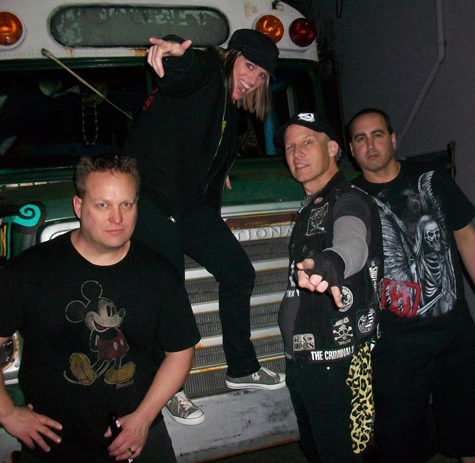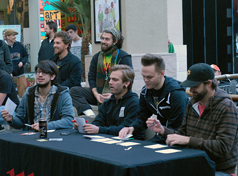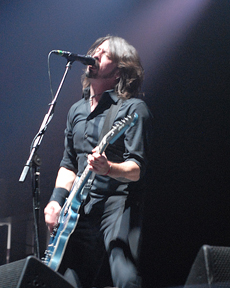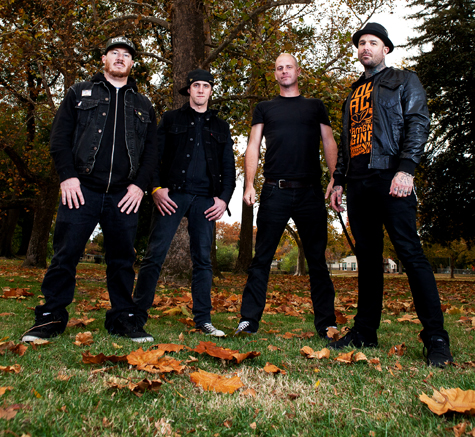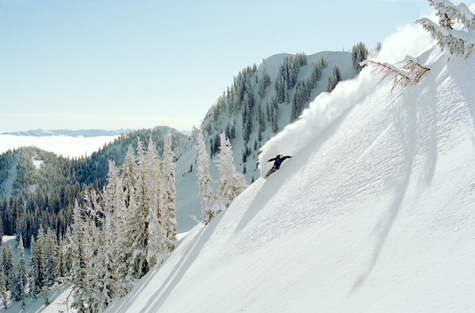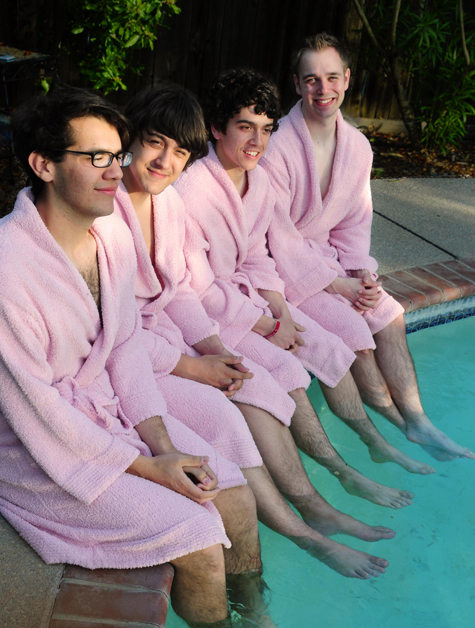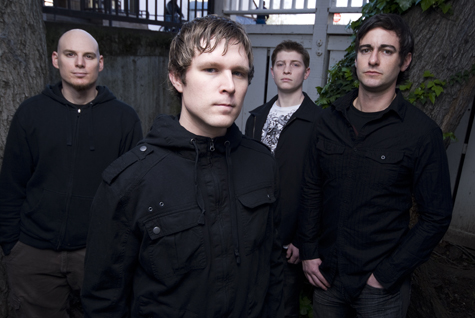Chicks rock, man: Brooke Sobol and Jason Moniz, two members of the now defunct local punk-rock band Blame Betty, have teamed up with Mickie Rat of The Secretions and drummer Brian Young to form Hey Pretty Pretty, a brand new female-fronted pop-punk/rock group that came together with the intentions of playing one night only. “I’m a huge fan of The Dollyrots. I’ve kept in touch with their booker over the years,” Sobol recently told Submerge. “She contacted me recently to see if I could help secure a venue for a show for them. I hadn’t been in the scene a while, so I contacted Mickie, knowing he is also a Dollyrots fan, for help.” The two chatted and quickly came up with the idea to get a new group together to open the show. Within 24 hours they had the full band formed and the opening slot secured.
“Mickie and I nearly hooked up before when he had Rat-O-Matic going, but it was super fast punk and I am more the ‘punk light’ type so that wasn’t the right fit,” said Sobol. “Hey Pretty Pretty blends punk and rock ‘n’ roll nicely, so it’s a good fit for both of us.”
When Submerge pried a little more to see if there’s a possibility the project might extend past the one gig, she said, “So far, it’s a one-night-only show for us, but there’s no telling for sure. Anything’s possible.” Catch them with Los Angeles’ The Dollyrots, also a kick-ass, female-fronted rock group, on Friday, April 13, 2012 at Blue Lamp. Capt. Billy’s Whiz-Bang is also on the bill. Party kicks off at 9 p.m., $8 cover, 21-and-over only.
Local pro skater and longtime musician Matt Rodriguez has a style all his own
For having had such a long, successful career as a professional skateboarder, going on trips around the world to film countless videos, landing in magazine spreads left and right, co-founding a popular footwear company called iPath, all while earning what many might call “legendary status” along the way, Matt Rodriguez is a really mellow, surprisingly normal guy. In fact, when Submerge arrived at Rodriguez’s Midtown house in early January, we found him in his backyard shoveling dog poop. See, pro skaters are just like you and me.
One major difference between Rodriguez and the rest of us, though, is that the remainder of his yard, the part not covered in dog doo doo, is made up of a custom skate park with ramps built from salvaged wood.
“It was kind of like a scavenger hunt,” Rodriguez said of his lengthy search for re-usable lumber. Although extremely well built, the ramps are steep and gnarly with tight, technical lines; definitely not easy to skate. In a way, that sort of sums up Rodriguez’s style. He’s known for rolling up to spots that to the untrained eye might not even look skateable, but before long he’ll have a couple tricks bagged and will be ready for band practice (he plays drums in local band The Storytellers as well as percussion in a musical experiment called Blktop Project with fellow pro skaters Ray Barbee, Tommy Guerrero and Chuck Treece). A dirty drainage ditch here, a makeshift plywood ramp leaned up against an electrical box there, and Rodriguez can make anything and everything he approaches on his skateboard, no matter how sketchy or unusual of a spot it is, look downright stylish.
Case in point: After an interview sitting with Rodriguez amongst the ramps in his backyard, photographer Wes Davis and Rodriguez set out on one of a couple missions to snap some photos to accompany this article and Submerge decided to tag along. After loading up a couple skateboards and a case of camera equipment into one car, we headed for a bank spot in West Sacramento near Raley Field that Rodriguez wanted to session. “It’s been here for years but was always fenced in, so I couldn’t get to it,” he said of the feature. The fence recently came down so he’s taking full advantage. As we rolled up to the spot, Submerge couldn’t help but notice that the small concrete bank Rodriguez spoke of was literally smack dab in the middle of a dirt field. Not where you would typically think to go to snap a photo of a skater, like, say, somewhere with more concrete.
“This is the story of my career, fucked up spots,” Rodriguez joked.
We arranged three or four long, narrow pieces of wood as his run-up to the bank to gain speed. He’d start in the dirt with his board in hand and would sprint toward the makeshift ramp, hop on his board and then pop a trick on the lip of the bank. Davis lined up the shot from a number of angles, at times getting down and dirty laying flat on the ground to get the proper vantage point.
“Sometimes you’ll be at a spot for hours trying to get a shot,” Davis said of the tedious art that is photographing skating.
Lucky for us, Rodriguez was on this particular day and half-an-hour or so later we had a few keeper shots, some of which show the Tower Bridge directly behind Rodriguez mid-trick. We’d captured two Sacramento icons in one shot, a success indeed.
After the dirt field bank spot, we headed around the corner to an entrance near the ballpark and immediately started, pulling pieces of plywood off of nearby lumber piles, building a makeshift launch ramp and a landing with a tall obstacle in the middle for Rodriguez to olly over. You know, another typical Rodriguez style set-up consisting of randomly found wood and obstacles. Just as we were about done with the set-up and Rodriguez was getting ready to hit it, we heard someone yell at the top of their lungs, “Hey!” and we saw what looked to be like a security guard pointing at us from a distance. We thought nothing of it until we saw him start running, so we scurried back to our car and hopped in before he could give us any shit. Crisis avoided.
“Just like the old days,” Rodriguez said, smiling ear to ear as we sped off, tires chirping.
On the car ride back to his house, Rodriguez spoke of wanting to get into photography, stating that it would be a good way to keep involved in the sport as he gets older. At 35, Rodriguez is surely no young buck, but one look at his part in the recently released iPath team video The Other Ones shows he’s still at the top of his game and likely will not be dropping off the radar anytime soon. “Trust me, I’ve been a part of a lot of videos,” Rodriguez said. “Some I’m proud of and some I’m not so proud of. This one, as a team we did some missions and covered some ground and gathered some good footage. It is what it is, I think it’s good, honest skateboarding.”
In the following interview with Rodriguez, you’ll learn more about iPath and his involvement in the company, his passion for music and how it ties into his skating, his love for Sacramento and tips for growing dreadlocks. Pick up The Other Ones at local skate shops or find it online by searching “iPath The Other Ones.”

What have you been up to lately? What have you been focusing your energy on?
Skate-wise, doing a lot with iPath right now, designing some shoes and trying to scout out some possible new members for the team. We just finished a video, The Other Ones, so just doing that, keeping that fire burning. And you know, music, The Storytellers and Blktop Project. We just did a Blktop tour in Japan.
How was that?
It was awesome, we went for eight days. It was great.
You were one of the original founders of iPath back in the late ‘90s. Since then the company has gone through a couple of ownership changes and it seems like it’s been on a bit of a roller coaster. What is your role at the company now?
Just someone who they, at least the new owners, look at as a headstone basically. Being there from the dirt up, going through all the metamorphosing, to team changes and new owners. Now it’s on its third owner, and hopefully its last. Just being someone who they look to for direction, being a skater, you know, they figure, “This guy knows what he’s doing and has been here from day one.”
I’ve read that Klone Lab, the new owners, want to get the company back to its roots. It’s got to feel good knowing that everyone is on the same page when it comes to realigning the company with it’s original values and image, right?
Yeah, whereas a lot of stuff changed when Timberland bought it. They hired a general manager, he came in and just cut half the team, and the half of the team that he cut were big personalities and a big part of the company, that makes up the vibe. A lot of stuff went through change then. But Timberland came into the situation not knowing who the hell was who in skateboarding. Through the time they had it, it grew and maxed out every year and was showing increasing growth, but I just think it wasn’t enough for them and they had other stuff on their plate. They actually sold Timberland, so the good thing is that they put iPath on the market for someone to take instead of canning it. They could have been like, “We’re over it, sorry.” But they realized that it’s a collective of skaters and artists, and a lifestyle even beyond just skateboarding, and they respected that and they wanted to give it a chance for someone else to take the time and energy. So Klone Lab stepped in.
It’s a tough market out there for small shoe companies, isn’t it?
Oh yeah, you’ve got companies like Nike, even all their pros that they pay to skate for their team combined is still barely a chunk of what they pay Tiger Woods. So skating for Nike, it’s fun, they can have fun with it, but it’s not their livelihood. With something like iPath, from the original investors to the investors now, that’s all they have, they have to make it work. But, you know, we’re just wanting to take more road trips, trying to get articles, making some films, get it all out there and just keep it going. Just keep trying to show the raw side and the soul side of skating.
As a company, especially coming from a grassroots budget, let alone motive, it’s not always easy. We don’t have X amount of dollars to just blow and have fun with, we have to make every dollar count. Granted, not everything runs smooth, even when you have all the dollars to wipe your ass or sweaty forehead with. But nonetheless it’s all about keeping going, nothing is going to be perfect. It’s like a band, sometimes a member gets fed up and can’t take it, or you want to bring a new member in, or someone wants to go in a different direction, or there’s a falling out. Whatever you have left, you have to work with.

The iPath skate team has gone through changes recently and a lot of people were dropped, right? Who is officially on the team now? I read somewhere it is just you, Fred Gall, Kenny Reed and Steve Nesser. Is that true?
Yeah, for right now.
About The Other Ones, there’s a long story behind why it didn’t get “officially” released through iPath, can you touch on that please?
It’s an independent effort from the team, because at the time iPath knew people were going to have to be cut, and they didn’t want to put it out as “the iPath video” and then a month later, half the team is gone. So for now, for our individual talent and credibility, the video is out. It’s out there as opposed to out of sight, out of mind. The team got together and were like, “Fuck it.” iPath still put in some money to produce it, most of the footage in that video is from iPath tours, so iPath is still a big part of it.
The song during your part, you recorded that right?
Yeah that was me and Tommy [Guerrero], that was just on the cuff. I was like, “Yo I want to come down and throw down a rhythm.” We set up the mics and just fucking went for it. He had a bass line and we just did layers.
Is this the first time you’ve recorded a song for a video part of yours?
No, I’ve done that before, but it was all percussion. This one was percussion, Tommy on bass, a little guitar, some melodica, some shakers.
Is that something you’ll continue to do? Not a lot of skaters can say, “That’s my song during my part.”
I figure whatever I have to offer, you know? I’m going to need a song, why not throw down a little something?
How old were you when you started playing music? What instruments were you first drawn to?
In fourth grade I definitely was tearing down boxes and buckets and banging away on anything I could get my hands on. We had an extra room and I lived on Madison and Sunrise, and it was like all around me. I just had like boxes and buckets and pans. I’d play with my mom’s coat hangers, I’d snap them so I had sticks. I finally got my first drum set when I was in sixth grade.

So it was percussion that drew you in?
Yeah, basically. Drumming and time, rhythms and patterns. I like how physically demanding it is, like skating. That’s what attracted me to skating, because I used to break dance when I was young in San Jose. So when I first seen skating…
Wait a second, that didn’t come up in my research! How into break dancing were you? And how old were you?
I’d go to battles, me and my older brother.
I was like 7 to 10 years old. Then I found my first skateboard when I was 10-and-a-half.
You found the board in one of your grandparents’ closets, right?
Yeah, my grandpa’s closet. It was my older brother’s, but I’d never seen him ride it. I was like, “Sick! Something to roll on!” From then on I met skaters, and they showed me Thrasher mag and who were the dudes. I was like, “Oh sick, there’s a whole world here.” I was captivated.
You’re 35 now and still going hard in such a physically demanding sport. How do you keep your body and mind so healthy and fit? What are your secrets?
It’s just will. I don’t ever see myself just being like, “Ugh I’m too old,” or mad I’m not getting paid, or being sent around to do demonstrations. I’m going to skate, go find a ditch and have at it.
You skate with your trucks ridiculously loose. What’s that all about?
Jeff Toland and Ricky Winsor and Sam Cunningham, so many amazing guys like that, I naturally gravitated to it because I grew up seeing it. Those dudes literally schooled me, I was basically blessed to grow up with those guys. They were raw, they rode their trucks super loose, they didn’t give a shit, they were like, “Fuck you, we’re skating! Don’t talk shit or we’ll caveman the side of your car’s fender.” They were just so raw. You know, back in the day learning flip tricks and whatnot… You evolve over time, your skating may change. I definitely realized my skating was changing and wanting to do something different. I always want to do something against the grain, you know. I get sick of seeing the same redundant shit out there. As far as skating with my trucks loose, that was just more of a way to be like, “How can I make my circumstances more screwed up and still pull it off?” Back then, they weren’t doing the tricks that are around today, but nonetheless, it’s possible. So I slowly worked my way looser and looser.
And now your trucks are barely on your board…
It’s a challenge, yeah. My board’s fucked, but I’m still rollin’ away!
Have you always called Sacramento home?
Pretty much, yeah. I moved here when I was 11-and-a-half. Grew up all around skating, knowing different skaters around the perimeter, downtown and all the outskirts. I moved back to San Jose when I was 16 for two years only to realize I just loved it up here, all the trees–the people, the pace, just the vibe, you know? The seasons, you can actually see them. And just the people, the friends I met through skating here. So I moved back after high school. I’ve been here ever since. I go around the world, I’ve seen a lot of beautiful places, but when I’m coming home to Sac, I’m like, “Ah man, good old Sac.”
Lastly, how long have you been growing those dreads?
Oh, this mop? Seven years. The secret to fast-growing, long hair is to eat a lot of beans. Lentils, peas and kidneys, it’s all the calcium.

Learn more about iPath at ipath.com. Pick up The Other Ones at local skate shops or find it online by searching “iPath The Other Ones.” Learn more about Blktop Project at Galaxiarecords.com/album/blktop-project. Look for upcoming Storytellers show dates at Facebook.com/sacstorytellers and expect a new album later this year. That Rodriguez, he’s a busy dude.
Mall walkers had reason to pause during their power walks last Sunday at the Westfield Mall. And no, it wasn’t to watch Santa Claus taking photos with crying babies or ice skaters taking falls at the rink. They paused to see the first Non-Drummer Drum-Off. The event is exactly what its name implies, people attempting to drum like Taylor Hawkins from Foo Fighters but they end up sounding like Animal from The Muppets. In fact, the only qualification of the drum-off was that you were supposed to suck. Even the Facebook event page said if someone was caught practicing before the show, then they would have been automatically disqualified.
Just like American Idol, the non-drummers had to face judges, listen to a sarcastic host and battle to win a prize. The eager non-drummers were going head-to-head for a chance to win a new drum set. At around 3 p.m., a small crowd gathered around a mini stage and bleachers on the second floor of K Street mall in Downtown Plaza that stood in-between the retail stores Express and ZuhG Life (organizers and sponsors of the event). When the show got rolling, most of the audience members ended up being random holiday shoppers, curious workers, or mall walkers who wanted to see what all of the ruckus was about.
The judges, including Matt Mingus from Dance Gavin Dance and Kevin Martinez from Tha Dirt Feeling, had to rate the non-drummers on a scale from 1 to 10 (10 being the highest) and on “charisma and performance.”
The bad drumming started off with Charleeé Wheeler from the local band ZuhG and his attempt to hit the drums like a rock star. Most of the contestants were familiar faces because they were from local bands or people who are active in the Sacramento community, such as Steph Rodriguez from Sacramento News & Review, Alexander Ayers from Prieta, a local photographer named Dennis, Michael Sean Flanagan, Dean Haakenson from Be Brave Bold Robot (who accidentally broke a drum stick while playing) and even our own Jonathan Carabba gave his shot behind the drums. After almost every performance, the host of the event (Blake Abbey from Musical Charis) would make funny, sarcastic remarks about their performance such as, “It’s so bad I want it to keep going,” or, “It wasn’t even entertaining to watch.” After Bryan Nichols, owner of the ZuhG Life store, gave his all playing the foreign instrument, Blake said, “I would rather listen to a whole Nickelback album than listen to that again.” Although the show was not exclusively awkward drumming, the audience members got to enjoy riffs from the professionals like Matt Mingus.
But the show stopper went to a small audience member who was eager to get a whack at the drums. When Blake asked if anyone from the audience would like to drum off, a young boy named Liam not only raised his hand to volunteer but stood up on the bleachers to be seen and heard. After he pulled a rampage behind the drums, he received a perfect score from the judges and huge cheers from the audience. And every time the host would mention his name he would stand on top of the bleachers and give an arm wave of victory. When he found out that he won the contest, he told his proud mom that they are going to need a “bigger truck” to carry his new gift home. Although little Liam arrived as a casual mall visitor, he left as a drumming champion.
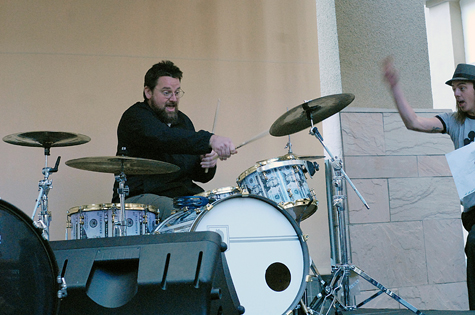
Dean Haakenson

Wes Davis
The Non-Drummer Drum Off
Westfield Downtown Plaza Mall, Sacramento – Sunday, December 4, 2011

Jesi Naomi
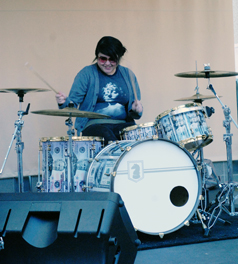
Steph Rodriguez
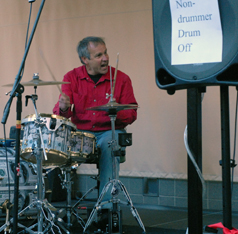
Dennis “the photographer”
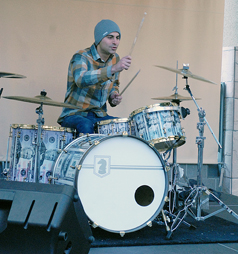
Jonathan Carabba
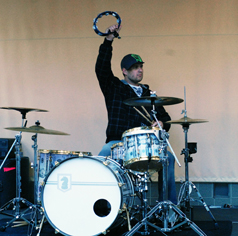
Doug Riggs

Michael Sean Flanagan
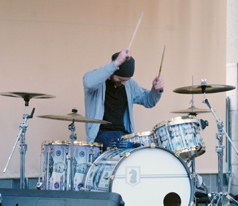
Alexander Ayers
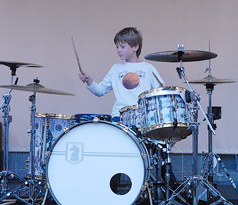
Liam
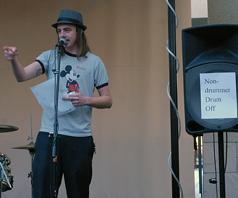
Blake Abbey
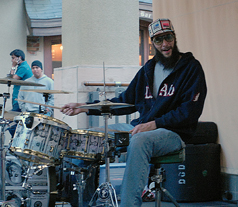
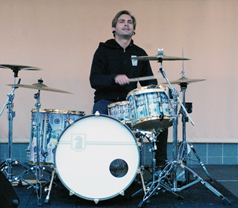
Matt Mingus
Foo Fighters, Cage the Elephant, Mariachi El Bronx
Power Balance Pavilion – Tuesday, Nov. 1, 2011
Twelve red semi trucks lined the northeast corner of the parking lot of Power Balance Pavilion on Tuesday, Nov. 1, offering a glimpse at the amount of gear this monstrous rock tour, featuring one of the world’s biggest bands, had traveled with into town.
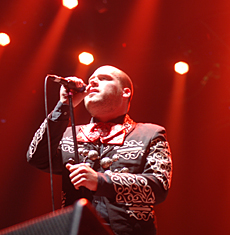
Upon walking into the arena just before the opening band started, one couldn’t help but notice a giant runway extending from the stage all the way to the back of the general admission floor area that created a rift between the crowd. And since this wasn’t a fashion show, it was apparent that someone would eventually rock the shit out of that runway and the mini-stage at the end of it. My money was on Dave Grohl. But first, Mariachi El Bronx took to the stage, all eight of them, and dazzled the crowd with their impressive and upbeat set. Mariachi El Bronx is the alter-ego of esteemed Southern California punk band The Bronx, and everything about them is authentic, from their instruments and their sound right down to their charro suits. They played to an ever-growing crowd, maybe two or three thousand (an usher informed Submerge he’d been told to expect 10,000-plus in attendance) scattered throughout the arena, most shoveling nachos or pounding over-priced beers.

Serving as main support to the Foo was Cage the Elephant, best known for radio hits like “Ain’t No Rest for the Wicked” and “Shake Me Down.” Lead singer Matt Shultz convulsed around the stage, shaggy long hair in his face, very Kurt Cobain-esque. He even flung himself off the stage a couple times, clearing the barriers (a solid seven- or eight-foot gap) into the crowd, resulting in some of the most Jesus-like crowd surfing possible. Overall, Cage the Elephant’s set was heavier than one might expect having only been exposed to the band’s more radio-friendly vibe. Their heads were down the whole time as they charged through their surprisingly scream-y and edgy sounding set. Definitely a punk-rock-meets-grunge sort of vibe, and Sacramento was into it.

At 9:03 p.m. the lights dimmed again and Foo Fighters burst into “Bridge Burning” and then “Rope” back-to-back, the first two tracks off of the band’s seventh studio album, Wasting Light, released on April 12 of this year. What followed was an onslaught of songs (over two dozen total, including a five-song encore) delivered with gut-wrenching passion. “My Hero” was played early on in the nearly three-hour set and Foo Fighters’ charismatic frontman Dave Grohl ran up and down the rock runway for the first time, shredding on his guitar and screaming in the faces of fans. During the same song, he incited a massive sing along and slowed the song down, then moments later they finished it off heavy-as-hell again. They had the crowd in their hands, taking the place from rocking and chaotic to mellow and serene, to rocking again in a split second. “I just want to make sure you understand you’re not going home early,” Grohl told the now-entranced crowd. “Get comfortable, you’re gonna be here a long fucking time.” People went apeshit.
After ripping through another 10 or so songs, including crowd favorites “Breakout” and “Monkey Wrench,” as well as a guitar solo-off between Grohl and fellow guitarist Chris Shiflett (during the song “Stacked Actors”), where Grohl was standing on the mini-stage at the end of the runway that had now been lifted a good 15 feet off the ground, the two faced each other down from opposite ends of the arena. It was impressive and fun to watch, but it drew a four-minute song into what felt like half an hour. Drummer Taylor Hawkins also squeezed in an impressive but maybe excessive solo at the tail end of one of the songs. Submerge would have liked to have seen some of the filler cut and replaced with B-sides from old albums. But, it was an amazing performance nonetheless and it’s safe to say the audience got its money’s worth. Grohl even put a local touch on the massive show. “I dated a girl from Sacramento,” he announced at one point, speaking in reference to professional snowboarder Tina Basich, who is from here. The two dated years ago. He apologized for taking so long to make it back to Sacramento, “It’s been eight years?” he said. “I’m sorry. We’ve been practicing for tonight.”
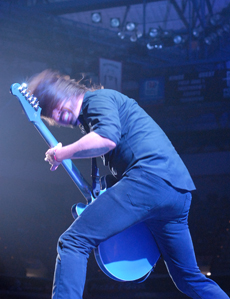
During their encore, Grohl first appeared with just an acoustic guitar to play a song called “Wheels.” “It’s big in Germany,” Grohl exclaimed. “If you’re louder than the Germans…” he said as the crowd sweltered. “OK, we’ll play a bunch more songs.” Grohl played a couple more acoustic songs, “Best of You” and a cover of The Beatles’ “Blackbird.” “Times Like These” started out with just Grohl on stage, asking the crowd to sing along, but halfway through, the full band kicked in, bringing the energy in the building back up to a boiling point. After blazing through the track “Dear Rosemary” and a cover of Tom Petty’s “Breakdown,” Foo Fighters closed the epic set with their smash hit “Everlong.” It was nearly midnight when the last note (more like feedback) rung out, well past most of the crowd’s bedtime, but you won’t find anyone complaining. Unless, that is, they have to wait another eight years to rock ‘til midnight with Foo.
Sacramento’s Lonely Kings are underground rock heroes
Although they may never have sold a million records, traveled to gigs via private airplane or experienced much else commonly associated with rock stardom, Sacramento-based Lonely Kings have long since established themselves as underground rock legends. They are a “band’s band,” if you will, and chances are, some of your favorite artists from back in the day have these guys’ cell phone numbers on lock. Formed in the early ‘90s by vocalist/guitarist/primary songwriter Jake Desrochers and drummer Jason Wilkinson (the two remaining original members; the group is now rounded out by bassist Emile Janicot and lead guitarist Johnny Deluca, both of whom have been in the band nearly a decade), Lonely Kings have had a long history of flirting with major success, coming ever-so-close time and time again to “making it big” and reveling in fame like so many of their close friends have. But they’ve never bitched or complained too much, never called it quits or took an elongated hiatus. Lonely Kings have always been there, a constant force in underground rock music and a fine example to bands young and old.
After performing countless self-booked tours and cutting endless demos and 7-inch vinyl splits throughout the early and mid-‘90s, Fearless Records released Lonely Kings’ debut full-length album What If? in 1999 to much critical acclaim. This led to tours with Agent Orange, A Static Lullaby, The Bled and others as well as dates on the infamous punk rock summer camp, the Vans Warped Tour. In 2001 the band went back into the studio with Cameron Webb (Social Distortion, Strung Out) to record their sophomore release, Crowning Glory, also released via Fearless Records in 2002. Other notable releases include two split CDs, one for Sessions Records and one for Coldfront Records, The Ides of March (out 2003 via Rise Records), and The End of Forever (out 2006 via Flight 13 Records). All in all, the Lonely Kings have completed 15 U.S. tours, been to Hawaii twice, Canada four times, Europe seven times (once with Hot Water Music in 2005), the United Kingdom four times (once with the Misfits), and a bunch of West Coast runs. They have become band buddies and/or have shared the stage with groups such as AFI, Papa Roach, At the Drive In, Thursday, Alkaline Trio, Strung Out, Sublime, Saves the Day–the list goes on and on.
Submerge recently sat down with Desrochers and Janicot to talk about their upcoming full-length record, American Heartache, their Rock for Tots charity gig at Ace of Spades on Dec. 23, 2011 and to bullshit about the band’s past.
I’m curious, having toured overseas so much in the past, what was the language barrier like?
Emile Janicot: I mean, I speak French and Spanish and a little bit of German. But really you just kind of speak rock ‘n’ roll, that’s what people know all over, you know?
Seeing so many groups around you “make it big” commercially, bands like AFI, Papa Roach, etc. What’s that like? Are you ever envious or jealous?
Jake Desrochers: It hurts every time for sure. Nowadays not so much, but when you see bands like you take off in the same year, the year that you’re the hottest your band has ever been… It was harder back then, because we were right there at the cusp.
And working hard, too.
JD: Yeah, exactly. Like we got bumped on a tour with Face to Face for Alkaline Trio. We got bumped on a second AFI tour one time because they took out Jimmy Eat World when they started to pop. So we’ve lost out to some amazing bands on some of those tours that could have broke us. Looking back, it’s just amazing to have been in the ring, but I was fucking pissed because I needed it. I don’t know though, it’s like we still get good gigs, so you could take it two ways. Some of these bands aren’t even around anymore.
EJ: A lot of these bands too like Papa Roach, Hot Water Music, AFI–we’re all friends with them. We get into all their shows free, they respect us, they’re always like, “We love your music!” But it’s hard to be like, “Give us a show. Give us this, give us that.”
JD: And knowing their lives, I don’t envy it sometimes. It’s super hard. I just try to feel like God or whoever is in charge had a different plan for us or for me personally, and just try not to fight it too much and to be grateful for what I do have, which is an amazing group of dudes that play quality American rock. We’re still doing it. Like, what the fuck? It’s crazy, after every practice I’m just like blown away.
I’ve always thought that Lonely Kings were one of those bands that has just as much “street cred,” if not more, than bands that started in the same place you did but made it huge. Would you agree?
EJ: We do have that!
JD: I don’t think we’d still be here if we would have gotten famous when we wanted to.
Yeah, how things would have changed if a major label came knocking? A lot of times it ends up being not the right move for the band.
EJ: We knew bands that did that; they got good really quick, they got signed and sponsored and this and that. We’d have already toured with them, and then they’d be done in two years. We’re still here.
JD: We’ve seen bands come and go. [Laughs] Hell, we’ve seen genres come and go.
Your band has always had a sort of rough-around-the-edges vibe. Has that been natural? Were there ever periods where you were trying to polish it up more?
JD: It wasn’t purposeful. Every record I’ve tried to make some pop masterpiece and to write that golden hit in the sky. I’ve tried every single time. But we are so rough around the edges, and I can’t write anything that doesn’t mean something to me. I can’t be too tongue in cheek, I can’t write all open chords, I have to keep it weird. As pop-y as it is, I want it to be just as weird, just to reflect what we’re going through. I just always liked bands’ bands in the way that there’s something raw to it. Maybe it’s my influences. But trust me, you think Fearless didn’t want to hear a hit? The second record, they wanted that to go, that was the whole plan. And they were sitting there in the studio screaming at me to come up with something. And then here I am writing it in Latin or some shit, shooting myself in the foot creatively, but I thought it’d be cool because it would be different. But sometimes what is different isn’t what’s cool.
EJ: Also, on our records we like to put out stuff that we can recreate live. A lot of bands have backing vocal tracks, backing guitar tracks and all kinds of triggers and stuff like that. We don’t use any of that, we are straightforward.
How does the material on American Heartache compare to past Lonely Kings releases?
EJ: It’s more mature. Jake and I have really found how to complete our songwriting craft, to strip away all the layers and all the bullshit. Only the best songs are going to make it. Some of the songs are different, but it’s going to be a Lonely Kings record for sure. We haven’t even heard the whole thing ourselves. All we hear are bits and pieces that Michael [Rosen, producer/engineer] sends to us.
JD: I don’t even care if it takes off or does well for us. I know I will have done my best work. And the fact we had to do it sporadically has made the songs so much better, because we’ve shed a couple every step of the way and really peeled the layers back to just quality shit. It was a two-year recording process, basically. It was as if someone gave you a studio for two years and told you to write a record.
EJ: We probably did 25 to 28 songs for this record, and there’s only going to be 10 or 11, maybe 12, on it. We might let Jake do an acoustic one by himself. It’s been a long haul, but it’s going to be worth it.
This record is yours in that you own the masters, not a record label. When it’s totally done are you going to pull in favors from old friends and/or shop it around? Or, do you think you’ll put it out yourself true DIY style?
JD: If it has to be, but it’s pretty freaking good so I’m hoping that someone will be like, “Damn!” and the songs will talk for us.
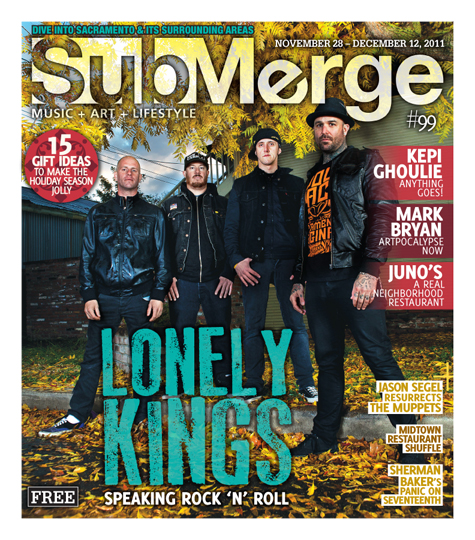
Look for American Heartache to be released sometime early next year. In the meantime, see Lonely Kings headline Ace of Spades on Dec. 23, 2011 at the bands’ sixth annual Rock for Tots, a toy drive for Sacramento Salvation Army. Bring a toy and receive a raffle ticket for prizes from local vendors. Doors open at 6:30 p.m., and the event is all ages.
Snowboard Film The Art of Flight Documents The Sport Like Never Before
For the action sports junkie, the recent release of the snowboard film The Art of Flight was something to freak out about. From Red Bull Media House, in association with Brain Farm Digital Cinema, the film follows superstar snowboarder Travis Rice and a heavy-hitting crew of equally talented associates including Mark Landvik, John Jackson, Scotty Lago, Nicolas Müller, Jeremy Jones and others around the world over a two-year period. It’s easily the most hyped film in the genre ever, boasting a massive budget (undisclosed, but easily into the millions) and insane camera technology capturing the world’s best riders conquering the most extreme terrain on the planet. It’s true: The Art of Flight is for snowboarding’s core fans, the guys and girls who call in sick to work on powder days and dream of chartered heli-ski trips in Alaska. But it’s also for anyone who enjoys beautiful cinematography, serene shots of awe-inspiring and otherworldly landscapes and a glimpse at some wildlife as well. Basically, it’s the gnarliest snowboarding ever mixed with shots that would make producers at Discovery Channel or National Geographic say, “I want that.”
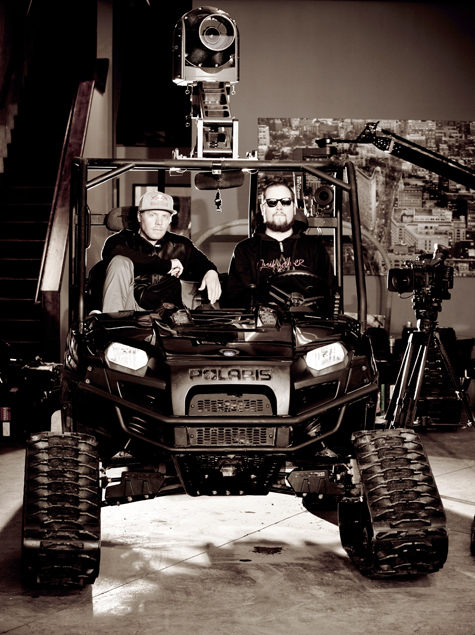
Travis Rice with film-maker Curtis Morgan | Photo: Stan Evans/Red Bull Content Pool
A quick search on YouTube for The Art of Flight’s official trailer will reveal that it’s been viewed upwards of 4 million times. Clearly, the film is catching the attention of the masses. Much of that is due to the unique, ultra-high-definition look of the film achieved by using state-of-the-art digital cinema and film equipment that producer/director Curt Morgan and his team at Brain Farm brought to the table. During the two-year filming project, which took them to places such as Chile, Alaska, Canada, Patagonia, Romania, Wyoming, Austria and others, the team used their Cineflex V14 and Phantom HD Gold cameras, among a bevy of others, to capture the sport of snowboarding in a manner previously unseen. The Cineflex, which can be mounted on a helicopter, snowmobile, ATV (pictured above), etc., relies on a highly accurate gyro-stabilization system (also used by the military and police) to provide amazing accuracy, sharpness and stability. The Cineflex has so much power, in fact, its use is controlled by International Traffic in Arms Regulations, which required that Brain Farm register it with the State Department. How gangster is that? The Phantom rig, on the other hand, is how they get mind-numbingly slow motion shots, as the camera is able to select any frame rate from 1 to 1,000 frames per second in increments of one frame per second at full HD resolution. In less nerdy terms, you can take a four-second clip of action and slow it down so much it’ll take four minutes to get through it. It’s simply stunning to see the level of tricks these riders are doing in such detail, slowed down and in full HD. It’s stunning to see anything in that much detail, as a matter of fact, and marketers all over are taking notice. Brain Farm’s impressive arsenal of equipment and overall knack for badass filmmaking has landed them some big-time gigs working on projects for companies like Visa and Suburu, even the U.S. Marines.
In 2008, Brain Farm and Travis Rice collaborated on what was up until now the greatest snowboarding movie ever called That’s It, That’s All. You may recall that we covered TITA right here in the pages of Submerge (“Out With the Old,” issue no. 20). All those years ago we asked Travis Rice, “You are all about progression, you have pushed the sport in new ways your whole career. After That’s It, That’s All, what the hell could be next for Travis Rice?” His response? “Oh, it’s in the works, man. In 2010 we’re going to shit all over this project. No, ever since we basically had our first premiere of this film we’ve been working on a new project. I guess That’s It, That’s All isn’t exactly the greatest title for following it up.” While Rice was off by one year, he was indeed correct in saying that The Art of Flight would shit all over TITA, because it surely has. With the level of riding being leaps and bounds better than what’s found in TITA, the over-the-top and insanely expensive equipment upgrades used to capture it and another bangin’ soundtrack, The Art of Flight is on track to become the greatest action sports movie of all time. That is, until Brain Farm makes their next one.
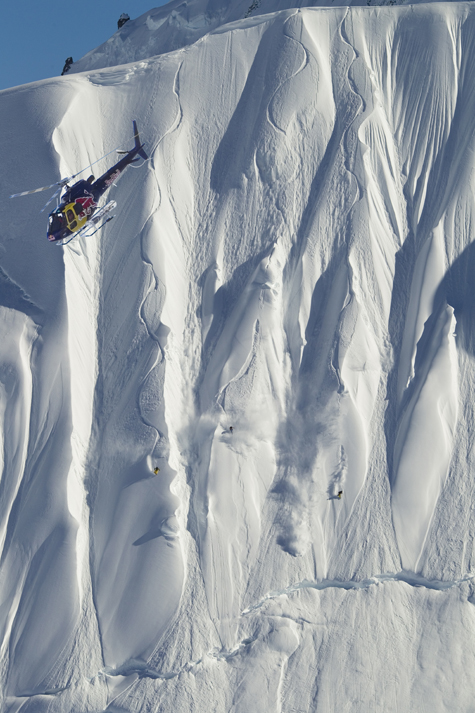
John Jackson, Travis Rice and Mark Landvik in action in Alaska | Photo: ©Scott Serfas/Red Bull Content Pool
The Art of Flight’s world premiere was Sept. 7 in New York City. The film is now available through iTunes and select retail locations. Northern Californians have a few opportunities to catch the film and meet Travis Rice and others on the following dates: Sept. 18 at the Resort at Squaw Creek in Olympic Village, Calif.; Sept. 19 at MontBleu Resort in South Lake Tahoe, Nev.; Sept. 20 at Crest Theatre in Sacramento, Calif.; and Nov. 3 at the Palace of Fine Arts in San Francisco. To view the film’s two official trailers and to purchase tickets to any of the screenings, visit Artofflightmovie.com.
Brodie Chaboya Spreads His Love of the Sport With Launch Wakeboarding School
There are two words that come to mind after getting to know Sacramento-based wakeboarder Brodie Chaboya during a recent interview that went into the wee hours of the night at Kilt Pub: passion and dedication. Not only has Chaboya spent half of his lifetime pushing himself to progress in the sport he so desperately loves, he’s also spent countless hours teaching and coaching others, spreading his infectious joy for wakeboarding. Simply put, he is an ambassador of the sport. A self-proclaimed “31-year-old kid,” Chaboya is living the dream, despite getting the occasional, “When are you going to get married?” or, “When are you going to buy a house?” from family members. He’s part of the national-level Hyperlite Wakeboards Legion Team, he manages the NorCal Hyperlite men’s team, he gets to wakeboard behind crazy-awesome boats every day and just last year he purchased the company at which he had previously worked for years, Launch Wakeboarding School. “One of my buddies told me, ‘It’s the American dream, you’ve been working for the company for so long and now you own it. How much more perfect could it be?’” Chaboya smiled, sipped his beer and said, “At this point I really can’t complain, it’s everything I ever wanted to do and so much more.”
Chaboya grew up in San Jose and was bitten by the wakeboard bug early in life. What started out as recreational skiing, kneeboarding and tubing with his family on local lakes quickly turned into an obsession. “I was probably about 16,” Chaboya remembers, “And I saw somebody go by on a wakeboard one day, well, back then it was called a ‘ski board,’ and this guy came by and did a back roll or something, just right in front of us. He was just full-on inverted, landed, rode by and I was mesmerized. I said, ‘Mom, I want to do that! I want one of those!’ So the next year I got a wakeboard for Christmas.”
That same year, Chaboya’s father bought a Mastercraft tournament ski boat, a huge step up from the runabout family-style recreational boat he had been riding behind. Now he had the board and the boat, but one critical piece was missing: the inspiration and motivation that can only be brought on from watching professional athletes at work. If you’re going to go skateboarding, you watch a skate video; if you’re going to go snowboarding, you watch a snowboard video; if you’re going to go wakeboarding, you watch a wakeboard video. It’s a ritual. So, Chaboya bought the “most hardcore” video out at that time, Gravity Sucks, which is, to this day, considered a classic among wakeboard enthusiasts. “So I got that video and I watched it every day, I was all stoked and fired up,” remembered Chaboya.
“I still have it to this day on VHS,” he said with a laugh.
From there his passion for the sport skyrocketed–and no longer was it just weekends that he was itching to go out and ride, it was all the time. Chaboya and one of his closest riding buddies even went all the way to Florida for an intense weeklong wakeboarding camp. “It was a big deal to go to a camp and ride our butts off for a whole week,” Chaboya said. “We had our own private coach, and it was just me and my buddy and our private coach just riding all day, every day. By the third day we were just dead tired. We could barely move. But we came back and we had learned a ton of stuff.”
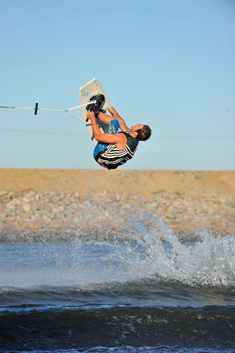
Photo by Riley Bangerter
Through being an all-around ripper on a wakeboard and his job working the pro shop at Cope and McPhetres Marine in Santa Clara, Calif., Chaboya was introduced to a bunch of industry connections, including an HO Skis/Hyperlite Wakeboards rep by the name of Joe Sassenrath. “I met him while working the shop,” Chaboya said. “He would come in and he was the total cool guy. He’d do demos and stuff, so I’d get to go on those.” Chaboya recalled one particular day where he was riding a board with “the hot new technology at the time” behind Sassenrath’s boat. “I threw down a decent set, rode pretty good, and I get back in the boat and he goes, ‘Hey, you rode really good on that board!’” Impressing Sassenrath with his skills was one thing; impressing him with his work ethic was another. “I started off riding for him and Hyperlite as a local and regional rider. It was basically just getting hooked up with product here and there and I’d go work sales and stuff, whatever I could do. You kind of earn your keep by helping out. If Joe needed help, I was there.”
Chaboya moved to Sacramento in 2001 to attend Sacramento State and kept in close touch with Sassenrath, who lives in Rocklin. Again, the young wake-rat showed his enthusiasm. “I just started working and doing everything I could,” Chaboya said. “I’ve pretty much been his right hand man since then for all the boat shows, wakeboard clinics, demos, sales, everything.” Also while at Sacramento State, Chaboya was re-connected with an old mentor of his, Ryan Fraser, who had helped teach him how to do one of his first inverted tricks way back when Chaboya was coming up. Fraser had started Launch Wakeboard School and was running lessons out of Folsom Lake. Naturally, Chaboya got a job as one of his coaches. “It was a killer gig while going to college, you know, making $12 an hour coaching wakeboarding. I couldn’t have been happier, it was a summer job and I got to ride every day. I was like, ‘Does it get better than this?’” The days were long and hot, though, as the company was booming, being among the top wakeboard schools in the region, maybe even the state. Twelve-hour days in 100-degree heat were commonplace in peak season and eventually it wore Chaboya down. “It was out of control, it was just crazy,” Chaboya remembered. “I couldn’t believe it. It was all day, every day.”
Eventually the two had “a little bit of a falling out” and Chaboya left the company. While he was gone, Fraser sold Launch to another one of Chaboya’s long-time riding buddies, a guy by the name of Ryan Ash, and according to Chaboya, “He just kind of let it go downhill. He just didn’t know what he was doing. He wasn’t the type that would be at the boat shows; he wasn’t in the industry.” Over the years, Ash would hit up Chaboya here and there to teach lessons, and he did, but eventually the company, much like the economy, started tanking and Ash just wanted out. “So last winter he was like, ‘Hey man, I’m done. This company fits you perfectly. You should just take it over. I’m done with it, I’m ready to throw it away.’”

Chaboya with a young student
Chaboya deliberated and eventually used every dollar he had saved from a gig working for the census and flat-out bought the company, the rights to the website (Launchwakeboarding.com–a site that Chaboya admits is outdated and “old-school”), and the company phone number, (916) 532-WAKE, a number that tends to ring all day as soon as the sun is out. “By the time I took it over it was mid-June last year and Ash goes, ‘I’m getting calls all day, every day, you can make your money back, it’s ready to go.’” Without regular access to a good boat to coach on, Chaboya spent last season doing private lessons on clients’ boats. “It went great,” Chaboya said of his first summer teaching lessons for the company he now owned. “I was getting busy, but not crazy busy. Busy enough to make my investment back, it was a crazy return on investment. I was stoked. I was just missing the boat thing.”

This year is different thanks to the folks at MB Sports Boats out of Atwater, Calif. hooking up Sassenrath and Hyperlite with a 2011 F21 Tomcat (sounds like some sort of jet but it’s really one helluva wakeboarding boat) that Chaboya has frequent access to. “I told them what I was doing and that I was fully insured as an instructor and MB was like, ‘We want that boat on the water every day.’” Now Launch Wakeboard School students will not only ride behind a state-of-the-art MB boat (if the Tomcat is preoccupied Chaboya has access to a number of other quality boats), they’ll also receive top-notch instruction from someone who’s been there, done that.
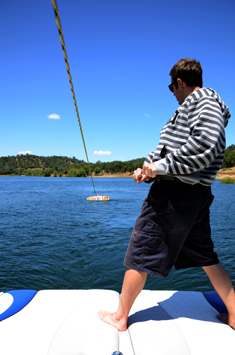
Brodie Chaboya teaching a student
“It’s a whole new level now,” Chaboya said of his recently rediscovered motivation to teach the sport now that the company is his. “I thought I was putting so much into it before, but it was kind of like, after that tenth hour of getting burnt out I probably wasn’t giving it a full 100 percent. Now, it’s like I’m giving it 110 percent every second. I pour my heart and soul into every lesson.”
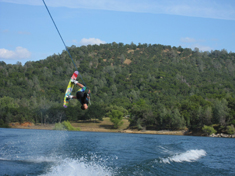
One of Chaboya's students, Ty Piearcy, throwing a tantrum
Most recently, Chaboya has been impressed with two 16-year-old students from Elk Grove, Frank Schultz and Ty Piearcy. Both are progressing at a fast rate and are competing regionally. “Every time I’ve gone out with them, they learn something new. For me, it’s like I’ve just been getting this huge over-enjoyment out of it.” He pointed out that the week he spent in Florida with a personal coach when he was a youngster still to this day plays a role in how he teaches others. “I kind of attribute a lot of the stuff I coach these days to that, like how to break things down for people and whatnot.”
The majority of Chaboya’s lessons are with beginners, and he says that he’s fine with that, to him there’s nothing like getting someone standing up on a wakeboard for the first time and getting them hooked on the sport. But, when he does get the opportunity to work with young, advanced riders, like Piearcy for example, he can have a larger impact on their riding. “He’s right at that level where he just needs one little turn of the wrist this way, or to look forward instead of backward, or to get his shoulders squared up, and then boom, he sticks it. I’m always the guy that’s like, ‘OK, you’re right there, one more, one more!’”
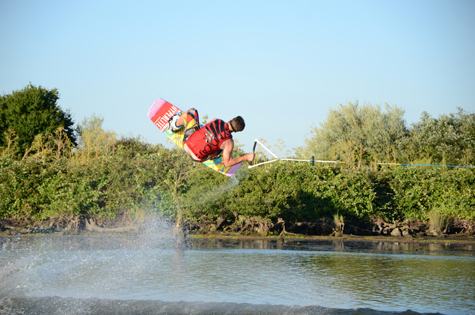
Chaboya killing it on the Delta / Photo by Andy Guillinta
Whether you’re a beginner trying to get up for the first time on a wakeboard or you’re an experienced rider and are trying to get inverted (and land on your feet, the most important part), Chaboya is your guy. Age doesn’t matter either, he has already taught 7-year-olds to 63-year-olds this summer. With a most certain determination to get Launch Wakeboarding School back to where it once was when he was just an employee there, Chaboya acknowledged how much things have come full circle for him. “It’s been a roller coaster ride, ups and downs, but it’s just been totally cool. It’s been a joyride!”
Contact Brodie Chaboya for more information about Launch and to learn how you can get out on the water and ride with him by either calling (916) 532-WAKE or by emailing him at bchaboya@gmail.com. Find him on Facebook by searching for “Launch Wakeboarding School.” Also, on the first Saturday of every month this summer you can find him at Swabbies on the River doing board demos all day. Summer is here, get out and shred!
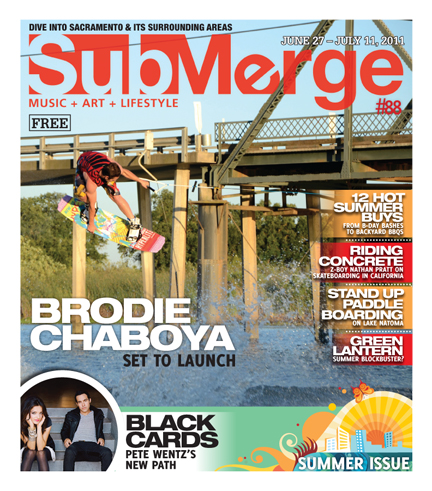
The Speed of Sound in Seawater Are Out For A Good Time
There’s been a lot of crazy shit happening around the world lately–maybe you’ve noticed? Earthquakes, tornadoes, Osama bin Laden’s death, all this nonsense about the Rapture! It can be overwhelming and downright depressing at times to turn on the news or read the newspaper, or, let’s face it, stare at your Facebook feed. For these reasons and so many others, it’s important to have creative outlets in life where you can simply have fun and get your mind off things. The members of local indie-pop-meets-math-rock band The Speed of Sound in Seawater know just this. “If we ever stopped having fun, we would stop making new music,” admitted lead vocalist and guitarist Damien Verrett during a recent conversation in a midtown coffee shop. “That definitely is key.” Fellow six-stringer Jordan Seavers (who also sings) agreed with that notion. “Obviously the music is important,” Seavers said. “But we’re not so much like, ‘We’ve got to make it as a band!’ We just have fun playing music.”
The theory of “having fun” makes its way into every aspect of the band: song titles, album titles, even their promo photos–one of which sees the four young gentlemen dangling their feet in a swimming pool while sporting pink bath robes. “There are so many stupid little inside jokes on the new EP,” said Verrett, referring to the group’s latest offering, a five-track EP released on April 27, 2011 titled Underwater Tell Each Other Secrets. “Lyrically, in titles, so much of it,” he said. “Even the name of the album, it’s just this stupid inside joke. It’s something Fernando [Oliva, drums, vocals] said like maybe three years ago. We were all swimming in the pool and he comes up and whispers to me, ‘Do you want to play underwater tell each other secrets?’” He laughed and continued, “I just thought it was the funniest thing ever, and we remembered it. When it came time to name the new EP we were like, ‘Let’s call it Underwater Tell Each Other Secrets.’”
“We’re all pretty goofy,” Seavers butted in. “We like to entertain other people but we like to entertain ourselves at the same time and just be goofs.”
All jokes and goofiness aside, The Speed of Sound in Seawater are a really talented band, and Underwater Tell Each Other Secrets showcases their ability to blend technically advanced playing (i.e.: a flurry of finger tapping, complicated hammer-on riffs, shifting time signatures and rhythms, etc.) with an undeniable knack for writing pop-y, memorable melodies. When listening to their songs, it’s difficult not to think of one the genre’s pioneers, Minus the Bear. Verrett recalls when he first heard the Seattle-based group. “I remember just finding them randomly on some forum and someone was calling it ‘math-rock,’ and I was, ‘What the hell is that? I’ve never heard of that.’ Then I listened to it and I was like, ‘Well, that’s exactly what it is.’” Verrett went on to explain how he thinks Sacramento natives Tera Melos and Hella are good examples of bands at one end of the math-rock spectrum as far as being “way out there and not as accessible,” and that groups like This Town Needs Guns and Maps and Atlases are at the other end of the spectrum and are becoming “indie sensations who have songs in commercials and stuff.” He went on to say, “I didn’t really know if those two sects of math-rock were aware of each other, but I feel like we’re more leaning toward the pop-y side. I like that about us.”
For Underwater… TSOSIS enlisted Robert Cheek as producer/mixer/engineer and from March 11 to 13 they worked out of The Hangar, arguably one of Sacramento’s most credible recording studios, where they did all the takes live. Seavers and Verrett both agreed that it was a sonic match made in heaven. “I was actually thinking about this last night,” Verrett said. “Just how many records he’s produced and engineered that I’m a huge fan of. There’s got to be like six or seven that are just some of my favorites.” He goes down the line: Tera Melos, RX Bandits, Mister Metaphor; all bands that TSOSIS share qualities with. “It just fit so well,” Verrett said of the pairing with Cheek. “He’s from here, he records all the music we love, he’s really experienced in the genre. He just got us instantly.”
For months leading up to The Hangar recording sessions, the band practiced full-on dress rehearsal style, setting up microphones around them and demo-ing their songs in the living room of the house in Elk Grove in which Verrett grew up. “We actually share the same practice space as Damien’s dad does,” Seavers joked, referring to Verrett’s father’s R&B cover band formerly known as The Detours.
“Once my mom gets home we have to play a little quieter,” Verrett joked. “I really don’t like having to quiet down, these guys are always like, ‘Oh, I’m sorry Mrs. Verrett, we’ll turn it down,’ and I’m always like, ‘No guys, we don’t have to do that!’ It’s really funny, that has to have influenced our music in some way.”
This is a fair assessment, considering TSOSIS rarely use distortion on their guitars, giving their music somewhat of a shimmer and an overall easier-to-listen-to vibe than bands with heavily distorted guitars constantly blasting. “Damien and I both really like jazzy tones and stuff like that,” Seavers said. Verrett jumped in, “And all the distorted parts hit so much harder when they’re so infrequent, you know? If there’s hardly any distortion, you really notice.” Their songs are consciously “loose,” too. Frequently, the skilled musicians will slip in and out of one part into another, sometimes perfectly in sync, sometimes not, giving their recordings an organic feel. “Sometimes I’m like, ‘Man we sound really sloppy, we need to clean it up,’” Seavers admitted. “But then sometimes I’m listening to another band and I’m like, ‘It’s so cool they’re sloppy, I want to play like that.’ It sounds a little more fun when people are sloppy.”
With a new EP freshly tucked under their belts, along with two others (2009’s Blue Version and 2010’s Red Version), TSOSIS has a plethora of songs to pull from when they tour throughout California this summer. “It’s odd that we’re at the point where people are like, ‘Oh your first EP is the best one!’” Verrett joked as our conversation was coming to an end. “It’s like, ‘Are you kidding? That was like $200 and we made it in like eight hours, and you think that’s the best? We just dropped a lot more on this one; you better think it’s the best.’”
The Speed of Sound in Seawater will play at Luigi’s Fungarden on Friday, June 17 alongside Town Hall, The Relatives and The Dreaded Diamond. Show starts at 8 p.m., is $5 and all ages are welcome. TSOSIS will welcome back their former bassist Lucas Ulrici for this show and a number of other performances this summer, as their current bassist Michael Littlefield will be busy recording with his other band, A Lot Like Birds. To learn more about TSOSIS and to stream or download tracks off all three of their EPs, visit Thespeedofsoundinseawater.bandcamp.com.
Ashley Fiolek is the new face of motocross
Ashley Fiolek is the type of chick that leaves boys in the dust, literally. And if they scream at her to “come back!” she won’t hear them. And it’s not her Honda’s 249 cubic-centimeter four-stroke engine’s growl that’ll drown out the sound. Fiolek, a 20-year-old professional motocross racer from St. Augustine, Fla., has been profoundly deaf since birth. In a sport dominated by both sound and men, Fiolek is causing a ruckus in the world of motocross.
In 2008 Fiolek dethroned five-time Women’s Motocross Association champion Jessica Patterson and became the youngest WMA champion ever. She has two X Games gold medals under her belt as well as a second WMA championship, was the first female in action ever to grace the cover of Transworld Motocross, the first ever female appointed to the factory Honda Red Bull Racing team and most recently Fiolek was featured as the central figure in a “World of Red Bull” TV commercial that is getting major primetime airplay. The epic minute-long commercial, shot at the picturesque Zaca Station motocross track in Buellton, Calif., features dramatic Indiana Jones-style music, fly-by helicopter shots, crazy 3-D POV camera technology, and of course, Fiolek ripping through the track like a true savage. The only catch, you don’t know it’s a girl the whole time. At the very end of the commercial, Fiolek pulls up to the camera, takes off her helmet revealing her long blond hair and says in American Sign Language, “Welcome to my world. The world of Red Bull.” Imagine millions of viewers’ jaws dropping when they realize that the mystery rider in the commercial is in fact a cute, young, deaf woman.
Fiolek has never been one to let her disability get in her way and she even goes as far as to say that it’s harder being a female in motocross than it is being deaf in motocross. “Most people have accepted my deafness pretty easily,” Fiolek told Submerge in a recent e-mail interview. “I have been riding and racing for a long time and people are just used to me being around.
“I think the women in my sport just struggle because it is a male-dominated sport and the girls get treated differently. Things have definitely changed since I have become a pro and for the better, so that is a good thing! Hopefully things will keep changing and maybe one year it will all be equal. I think in general women in most sports are not treated the same as men. It is just something we have to keep working on and trying to change.”
And to all the naysayers reading this thinking, “She’s probably just good for a girl,” know this: Fiolek is fast. Very fast. Don’t believe us? Take Travis Pastrana’s word instead. Pastrana is the most successful competitor in the history of X Games freestyle motocross and a dude who knows something about going fast, as his list of motocross winnings is too long to list. On the back cover of Fiolek’s book (yeah, she even co-wrote a book) called Kicking Up Dirt, Pastrana is quoted as saying, “It’s difficult to imagine that such a petite girl with a warm smile could be so phenomenal in an extreme sport like motocross. But Ashley Fiolek’s not just good for a girl…she’s flat-out good.”
You can catch Fiolek and other top motocross riders, in action right in our own back yard on Saturday, May 21, 2011 at the 43rd Annual Hangtown Motocross Classic in Rancho Cordova. Read on to learn more about this fascinating and inspiring young athlete.

Photo: ©Simon Cudby/Red Bull Content Pool
What have you been up to lately?
I normally head out to California to train but right now I have stayed at home in Florida. We have had very good weather and no rain so it has been good! I have just been riding and training and hanging out with my friends.
What have you been doing to get ready for the upcoming motocross season? What is your training regimen like both on and off the bike?
I normally take some time off then I start back up riding and training at the New Year. I ride as much as I can during the week, and then I do a cardio and strength training program for off the bike stuff.
Last year you finished second overall and in truly dramatic fashion. It came down to the very end between you and your “rival” Jessica Patterson. Was that a tough loss for you? Has it motivated you to work harder to re-claim your throne this year?
Yes, it is always hard to lose! Anyone that is competitive knows that. I have definitely been motivated this year, and I hope it all pays off.
How important is winning to you? Is it everything, or is it just one thing?
It’s everything! Well it is pretty important. No one likes to lose.
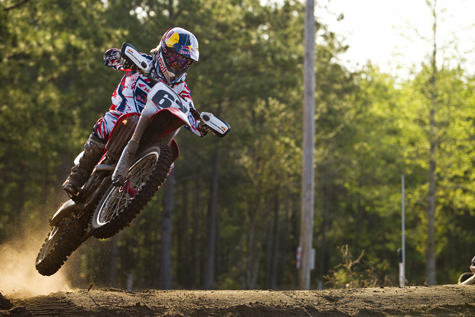
Photo: ©Garth Milan/Red Bull Content Pool
I’ve heard you say in past interviews that you “live and breathe motocross.” Can you imagine what your life would be like without it? Where do you think you’d be today if you never started riding?
Wow, I am not sure what I would do if I wasn’t riding, but it would definitely be some kind of sport! I am not one to just sit around and do nothing; I like to be active and moving.
I’ve seen the footage of when you fell and injured your collarbone in a Sept. 5, 2009 race. I was amazed how fast you popped right up and got on your bike despite having just fallen so hard. That shows a lot about your character. Is falling something you think about often while riding? It seems like it would be hard not to.
Well, of course you don’t want to fall! It is part of our sport not if you get hurt but when. When I am out riding I really don’t think about it and hopefully it won’t happen! During that race, I knew I had to finish 11th place or better for the championship, so knowing that and with my adrenaline pumping I just kept going.
You’ve received some major press over the past couple of years and have become the face of women’s motocross, if not motocross in general. Seeing as how you are a huge figure and role model in your sport, do you ever feel pressured or stressed out?
Well sometimes I do feel pressure. I am only 20 and it is a lot to think about! I just always try to do my best and be the best role model I can be. I want our sport to grow so whatever it takes to get women’s motocross out there is good for me.
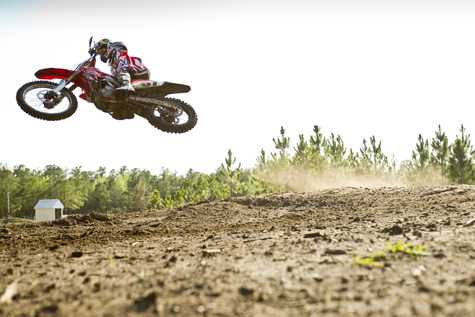
Photo: ©Garth Milan/Red Bull Content Pool
I want to talk a bit about the new World of Red Bull commercial. It’s an incredible ad and I’ve seen it on television a number of times in the past few weeks. How does it feel knowing that literally millions of people are going to see that? That’s got to be a gnarly feeling!
Oh yes. It is incredible! I didn’t really realize how many people would see it or how far it would reach, but the response has been crazy. It is strange to know that so many people are seeing it. My mom was watching cartoons on the FOX network the other day with my brother and it came on. Go Red Bull!
How shocked do you think most people are at the very end of the commercial when you take your helmet off and they see that A) you are a girl, and that B) you’re deaf? I bet the look on most people’s face is priceless.
I hope people are shocked. For me and my family it is hard to watch the commercial thinking I am a guy, because we know it is me. Some people that I know, that didn’t know about the commercial, were shocked. They didn’t realize that it was me until the end! I am sure most people that are not into motocross are probably more shocked that I am signing at the end.
What are your techniques to make sure you get in front, and stay in front, of other racers? How does being deaf play into these techniques? What sort of signals or indicators are you looking for when you’re riding?
Well you have to try and get the “holeshot,” this is to be the first one to the first turn. It is hard to be out in front but you have a clear view of the track so that is good. If I get the holeshot, I just try and push myself hard and stay in front. My mechanic will give me info on the pit board when I come around to the mechanics area so I know where the next rider is at.
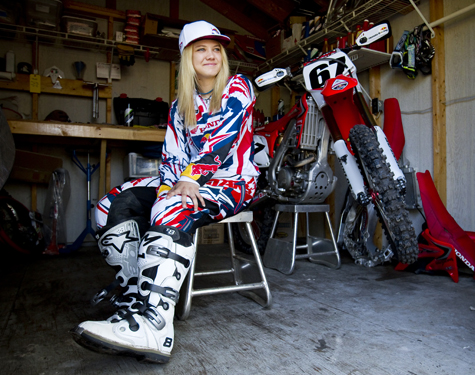
Photo: ©Garth Milan/Red Bull Content Pool
Switching gears a bit. Tell me about your book that was released last year, Kicking Up Dirt. What inspired you to want to write a book?
Well I hadn’t really thought about it much, but a woman that interviewed me one time for a magazine wanted to write a book with me about my life. She approached me and we started working on it together, and my mom and dad helped too with some early on info from my life.
Is writing something that you particularly enjoy? What are some of your other hobbies? When you have free time (if any), what do you do for fun?
It was a lot harder to write a book than I thought! It was a lot of research and a lot of interviews. It took over a year to do and it was pretty intense, but I am glad that it happened; in the end I really liked the book! In my free time I like to Jet Ski and snowboard or ride pole position cars, anything crazy.
Any final shout-outs you’d like to give?
Well I would definitely like to thank my sponsors who have stuck behind me all these years. Alpinestars, Red Bull, Honda, Leatt, they have been with me almost since the beginning of my pro career. Alpinestars and Red Bull were with me in my amateur career! My mom and dad have been great, they have helped me with everything and are always there for me. I wouldn’t have made it this far without them for sure! God is definitely looking over me.
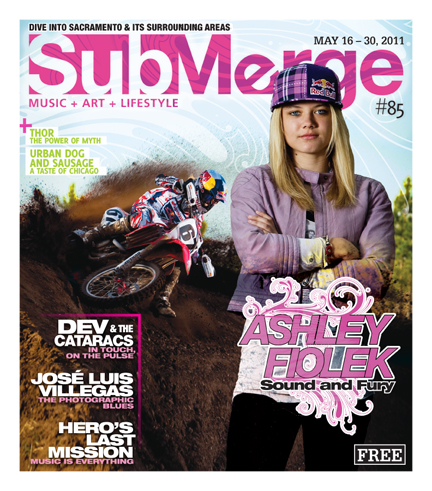
See Fiolek and other top pros in action on May 21 at the 43rd Annual Hangtown Motocross Classic in Rancho Cordova. Hangtown is the longest running and largest of the outdoor national motocross series and it is still being promoted and produced by a local club, the The Dirt Diggers North Motorcycle Club. The greater Sacramento region has the DDNMC to thank for bringing the fastest motocross racers in the world to our own back yard for the past 43 years. Our hats are off to them! Visit Hangtownmx.com or call (800) Hangtown (426-4869) for more information. To learn more about Fiolek and to watch her World of Red Bull commercial, visit Ashleyfiolek.com
Local hard rock band Misamore ready to release new EP
For local rock guitarist Josh Amolsch, April 13, 2011 is a very important date, one that’s long overdue. The band he founded way back in 2003, Misamore, will finally release their first official recording, a five-track EP titled Horizon, at Powerhouse Pub in Folsom. “This album has been a very long time coming,” Amolsch recently admitted to Submerge. “Every time we tried to put something out it always ended up going sideways due to one reason or another. So having this album finally come together is a huge achievement for this band.”
He added, “This record was kind of ‘do or die’ for us.”
Misamore’s sound lies somewhere between that of Tool, Pantera, Mudvayne and Metallica. The EP’s opening track, “The Desert Shade,” boasts speedy guitar riffs and a huge range in singer Mace Corona’s vocal abilities, who can change from melodic hook to brutal scream in a heartbeat. “New Beginning,” the second track, has a much more radio-friendly vibe to it, but still showcases the band’s musicianship and knack for weaving in oddly timed rhythms seamlessly. “Dead” is a whole lot slower than the first two songs and acts as a great centerpiece for the EP. “Forebay” gets a little tripped out at times, sort of Mastodon-ish, and proves that Mike Dragony can slap the shit out of his bass with some impressive playing in the intro; and “Home” brings Horizon to a close, leaving you wanting more.
Submerge caught up with Amolsch recently to chat about the band’s tumultuous past, their new EP and the status of heavy music today.
Why did it take so long to get an official release together? There have been quite a few ups and downs for this project, right?
Well, we had never had a full band together long enough to put a legit album out. We are very meticulous with everything we do and didn’t want to put out something we weren’t proud of. With that, there have definitely been more downs than ups. Misamore first came together in February 2003 after my old band broke up. I, along with the drummer from that band, launched Misamore. The next four-and-a-half years saw many member changes, a move out to Texas and back and a brief period of time when I just flat gave up and started playing drums in a punk band.
How did the current lineup come about?
I have known Mike for years. I first met him back in 2000 when both of our bands played a show up in Chico at a house party. We met Mace through an ad on Craigslist in 2008 and although it took a year to finally hook up, it clicked right away. Mace met Ryan [Maples, drums] at our rehearsal spot back in December 2010 just walking in the front door. I’m told that Mace just had a weird feeling about this guy and turned around and asked him if he played drums. We had fired our old drummer about three months prior to starting the record, so we were looking for a permanent replacement.
Being the group’s founder, are you also the main catalyst for songwriting? How does that process work for you guys?
I think we work very well together. Mike and I have been writing together for years. He and I will just sit, sometimes for hours and just pound out riffs. We record everything too. I must have 60 gigs of material just sitting on hard drives around my house. We will then sequence riffs together based on vibe, tempo and energy to make sure we are capturing the right feel Mace needs to get across what he feels. And then there is Ryan. He makes sure everything flows and bounces according to his standards. It really is the most healthy writing routine I have ever been a part of.
When were the songs on Horizon written? Are these all older, newer or a mix of the two?
Definitely a mix. It was tough deciding which songs would make it on the debut, but we narrowed it down the five we felt would represent us the best and reach the most people. The oldest song on the EP is “The Desert Shade.” I wrote that song back in 2006 when I was in Dallas. The most recent one is probably “Dead,” written in November 2009.
What are your thoughts on the status of heavier music today? It seems that with all of metal’s sub-genres it’s easy to get classified as “this” or “that” and sort of get pigeonholed, you know? What does a band like Misamore have to do to stand out from the rest?
Well, I am only speaking for myself, but I think that a lot of the heavy music out today sounds very similar. To my ears, there are very few bands that stand out lately. Looking at the big picture there are always trends. Right now, in metal, I just hear breakdown after breakdown accompanied by myriad screams with techno beats for effect. Although it was kind of cool and different when I first heard it, I’m rather bored with it now. I can’t tell if it is my ADD or just my yearning for a new wave of timeless tunes. Misamore is all about energy. We pull from Muddy Waters to Norma Jean. At the end of the day it’s not about how hard a song is or if we got enough double kick or guitar harmonies in there. We want our songs to be in people’s iPods 20, 30, 50 years from now. That is our goal.
What’s more important to you, sounding good live or sounding good on record?
I would have to say sounding good live. However, most people will come to your show based on a good recording. I like the old fashioned word of mouth and the respect that it brings from friends of friends telling their friends and so on. It’s kind of like we are all just a bunch of friends when we get to the venue. Life feels so synthetic lately with computers and texting and social networking; to get in front of a bunch of people and exchange energy with them, that is living man.

